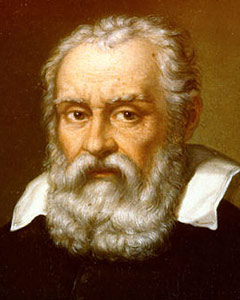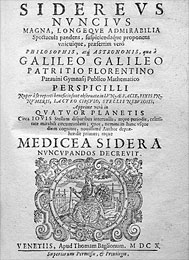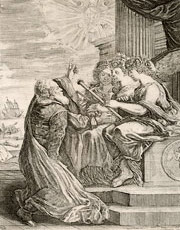
Galileo Galilei
1564 - 1642
Italian astronomer, mathematician, and philosopher.
First to observe the moons of Jupiter and the rings of Saturn with a telescope.
Supporter of the heliocentric (Sun-centered) view of the Solar System and heretic to the Holy Roman Church.

Galileo is often referred to as the first modern physicist. He was born in Pisa, Italy on February 15, 1564. His father was an accomplished scholar and he taught Galileo his love for learning. His father encouraged him to study medicine and he eventually enrolled in the University of Pisa. While at the university, Galileo's interests soon turned to mathematics and natural philosophy. He left the university without earning a degree. He was later appointed professor of mathematics at the University of Padua (the university of the Republic of Venice) in 1592, where he remained there until 1610. His duties there were mainly to teach Euclid's geometry and standard (geocentric) astronomy to medical students, who were required to know some astronomy in order to make use of astrology in their medical practice. During this time, Galileo's astronomical ideas were to become much more unconventional. No public sign of this belief would appear until many years later.
In the summer of 1609, Galileo heard about heard about a spyglass that a Dutchman had shown in Venice. Using these reports and his own technical skills, he created his own telescopes which were far superior in performance to the Dutch instrument. With these instruments he viewed the Moon, and was the first person to observe the mountain ranges, mare (seas), and other features. He observed Saturn and its rings, which he described as "ears", and the four largest moons of Jupiter, which are now referred to the Galilean satellites in his honor. His observations were later published in a work entitled Siderius Nuncius (The Messenger of the Stars), which he wrote in 1610. It caused a sensation following its publication. While Galileo is remembered for his work on free fall, his use of the telescope and his employment of experimentation, he is perhaps most famous for his controversial views of natural law than for his actual contributions to science. He believed that the Sun, not the Earth, was at the center of the universe. This belief, known as Copernicanism was at odds with that of the Roman Catholic Church, which was Earth-centered. His works were later included on the "Vatican Index" of disapproved works. They were only recently removed from the list.

Because of these beliefs, Galileo received a secret and official warning from the church in 1616. It stated that he was to refrain from defending Copernicanism. In 1622 he wrote the Saggiatore (The Assayer, which was approved and published in 1623. In 1632 he published his Dialogue on the two chief world systems in Florence. In October of 1632 he was summoned by the Holy Office to Rome. The tribunal passed a sentence condemning him. He was also required to state an oath before the Holy Roman Church in which he was forced to renounce his belief that the Sun was at the center of the Solar System. He was sent to exile in Siena and finally, in December of 1633, he was allowed to retire to his villa in Arcetri, the Gioiello. His health was steadily declining and by 1638 he was completely blind. Galileo died in Arcetri on January 8, 1642. It was not until many years after his death that his work and discoveries were realized as the groundbreaking achievements they were.




